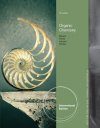About this book
Succeed in the course with this student-friendly, proven text. Designed throughout to help you master key concepts and improve your problem-solving skills, Organic Chemistry, 7th Edition includes a running margin glossary, end-of-chapter in-text mini study guides, a focus on "how to" skills, and more in-chapter examples and problems than any text on the market. To help you understand reaction mechanisms, the authors offset them in a stepwise fashion and emphasize similarities between related mechanisms using just four different characteristics: breaking a bond, making a new bond, adding a proton, and taking a proton away. Thoroughly updated throughout, Organic Chemistry offers numerous biological examples for premed students, unique roadmap problems, a wide range of in-text learning tools, and integration with an online homework and tutorial system, which now includes an interactive multimedia eBook.
New to this edition:
- MCAT PROBLEMS: To better prepare students for the upcoming new MCAT exam, the new edition includes MCAT PRACTICE: PASSAGE AND PROBLEMS throughout the text. First students read the organic chemistry-related essay and then answer a series of multiple-choice questions.
- NEW PRIMERS: Two new primers (Developing a Reaction Mechanism before Chapter 6 and Carboxylic Acid Derivative Reaction Mechanisms before Chapter 18) set key and possibly difficult concepts apart for easy reference to enhance student understanding.
- NEWLY-DRAWN ORGANIC CHEMISTRY REACTION ROADMAPS: Creating a cumulative, graphical representation of the different reactions students encounter in the context of important functional groups, the organic chemistry roadmaps help students visualize how to interconvert different functional groups (which often require different reactions from different chapters) by simply identifying the most direct path on the roadmap. New pull-out cards show the roadmaps in sequential order.
- REVISED REACTION ROADMAP PROBLEMS: These unique problems relate to the authors'' organic chemistry roadmap (see above), which compares organic chemistry to a roadmap, with functional groups analogous to cities and reactions analogous to the roads between them.
- FIVE NEW "HOW TO" BOXES: Integrated throughout the text at strategic points, the new boxes show students: "How To: Quickly Figure Out Formal Charge," "How To: Quickly Recognize the Hybridization and Geometry of Atoms," "How To: Quickly Draw and Recognize Enantiomers and Diastereomers," "How To: Retrosynthetically Dissect an Amine into the Proper Starting Materials for a Reductive Amination," and "How To: Recognize Aromatic Compounds: Criteria and Caveats."
Contents
1. Covalent Bonding and Shapes of Molecules.
2. Alkanes and Cycloalkanes.
3. Stereochemistry and Chirality.
4. Acids and Bases.
5. Alkenes.
Primer I: Reaction Mechanisms
6. Reactions of Alkenes.
7. Alkynes.
8. Haloalkanes, Halogenation, and Radical Reactions.
9. Nucleophilic Substitution and B-Elimination.
10. Alcohols.
11. Ethers, Sulfides, and Epoxides.
12. Infrared Spectroscopy.
13. Nuclear Magnetic Resonance Spectroscopy.
14. Mass Spectrometry.
15. Introduction to Organometallic Compounds.
16. Aldehydes and Ketones.
17. Carboxylic Acids.
Primer II: Carboxylic Acid Derivative Reaction Mechanisms.
18. Functional Derivatives of Carboxylic Acids.
19. Enolate Anions and Enamines.
20. Dienes, Conjugated Systems, and Pericyclic Reactions.
21. Benzene and the Concept of Aromaticity.
22. Reactions of Benzene and Its Derivatives.
23. Amines.
24. Catalytic Carbon–Carbon Bond Formation.
25. Carbohydrates.
26: Lipids.
27. Amino Acids and Proteins.
28. Nucleic Acids.
29. Organic Polymer Chemistry.
Appendices:
1. Thermodynamics and the Equilibrium Constant.
2. Major Classes of Organic Acids.
3. Bond Dissociation Enthalpies.
4. Characteristic 1H-NMR Chemical Shifts.
5. Characteristic 13C Chemical Shifts.
6. Characteristic IR Absorption Frequencies.
7. Electrostatic Potential Maps.
8. Summary of Stereochemical Terms.
9. Summary of the Rules of Nomenclature.
10. Common Mistakes in Arrow Pushing.
11. Organic Chemistry Roadmaps.
GLOSSARY G-1
INDEX I-1
Customer Reviews
Biography
William H. Brown is emeritus professor of chemistry at Beloit College, where he was twice named Teacher of the Year. His teaching responsibilities include organic chemistry, advanced organic chemistry, and, more recently, special topics in pharmacology and drug synthesis. He received his Ph.D. from Columbia University under the direction of Gilbert Stork and did postdoctoral work at California Institute of Technology and the University of Arizona. He is a coauthor on Introduction to General, Organic and Biochemistry, 10e.
Eric Anslyn is the Norman Hackerman Professor of Chemistry at The University of Texas at Austin. Highly respected in organic chemistry, he earned his Ph.D. from the California Institute of Technology and has won numerous teaching awards. Anslyn's research focuses on the cutting-edge area of bioorganic chemistry.
Brent L. Iverson received his Ph.D. from Stanford University in 1982 and currently teaches at University of Texas, Austin. He is a distinguished teacher and respected researcher. Iverson's research group has developed methods for recombinant antibody or enzyme cloning and has directed its evolution. In collaboration with the Georgiou group, he pioneered a novel E. coli surface expression/FACS selection technology that has allowed the group to enhance antibody affinity.
Christopher S. Foote received his B.S. in 1957 from Yale University and his Ph.D. in 1962 from Harvard University. His scholarly credits include Sloan Fellow 1965-1967; Guggenheim Fellow 1967-1968; ACS Baekland Award, 1975; ACS Cope Scholar, 1994; Southern California Section ACS Tolman Medal, 1996; President, American Society for Photobiology, 1988-1989; and Senior Editor, ACCOUNTS OF CHEMICAL RESEARCH. He was Professor of Chemistry at UCLA.


























